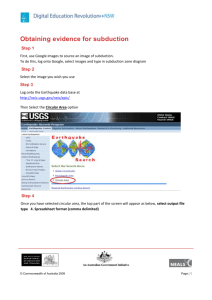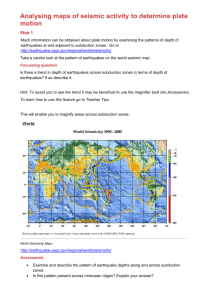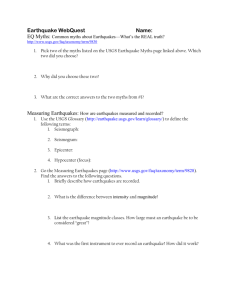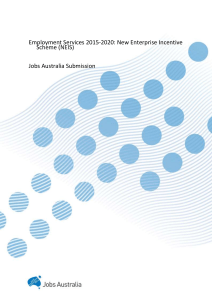Global Earthquake search
advertisement
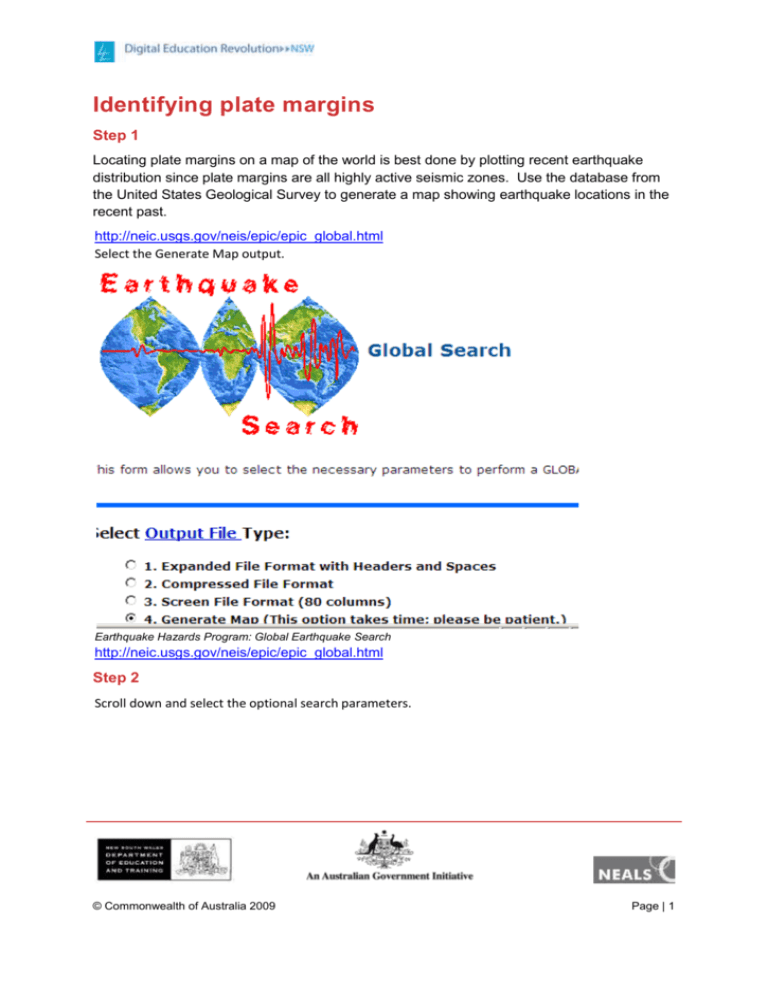
Identifying plate margins Step 1 Locating plate margins on a map of the world is best done by plotting recent earthquake distribution since plate margins are all highly active seismic zones. Use the database from the United States Geological Survey to generate a map showing earthquake locations in the recent past. http://neic.usgs.gov/neis/epic/epic_global.html Select the Generate Map output. Earthquake Hazards Program: Global Earthquake Search http://neic.usgs.gov/neis/epic/epic_global.html Step 2 Scroll down and select the optional search parameters. © Commonwealth of Australia 2009 Page | 1 Earthquake Hazards Program: Global Earthquake Search http://neic.usgs.gov/neis/epic/epic_global.html Select only a period of months. The output produced will show the concentration of earthquakes occur in zones or along lines on a world map. These lines of high levels of seismic activity are plate boundaries. © Commonwealth of Australia 2009 Page | 2 NEIC: Earthquake Search Results http://neic.usgs.gov/cgibin/epic/epic.cgi?SEARCHMETHOD=1&FILEFORMAT=5&SEARCHRANGE=HH&SYEAR=2009&SMONTH=1&SDAY= 1&EYEAR=2009&EMONTH=07&EDAY=1&LMAG=2&UMAG=10&NDEP1=&NDEP2=&IO1=&IO2=&SLAT2=0.0&SLAT1=0.0&SLO N2=0.0&SLON1 =0.0&CLAT=0.0&CLON=0.0&CRAD=0&SUBMIT=Submit+Search Note the legend on the output map that shows the depth of earthquake activity is represented as a bar graph on the side of the output. Where earthquake depths are indicated as consistently at 33 km or shallower then that zone is a spreading zone or midocean ridge. These zones are where new crust is made or are divergent margins. Where earthquakes are shown as predominantly deeper that 70 kilometres then this is an indication of a convergent margin or zone where crust is destroyed often called a subduction zone. © Commonwealth of Australia 2009 Page | 3 Step 3 Perform a new search to show only subduction zones by changing the search parameters to search only for earthquakes deeper than 120 km during the same time frame. Earthquake Hazards Program: Global Earthquake Search http://neic.usgs.gov/neis/epic/epic_global.html The search output will show clearly the major subduction zones active on the Earth's surface. © Commonwealth of Australia 2009 Page | 4 NEIC: Earthquake Search Results http://neic.usgs.gov/cgibin/epic/epic.cgi?SEARCHMETHOD=1&FILEFORMAT=5&SEARCHRANGE=HH&SYEAR=2009&SMONTH= 1&SDAY=1&EYEAR=2009&EMONTH=07&EDAY=1&LMAG=2&UMAG=10&NDEP1=100&NDEP2=800&IO1=&IO2=&SLAT2=0.0& SLAT1 =0.0&SLON2=0.0&SLON1=0.0&CLAT=0.0&CLON=0.0&CRAD=0&SUBMIT=Submit+Search Assessment 1. Download a blank map of the world, and on it identify and draw zones on the Earth’s surface where you believe the earthquake evidence indicates the existence of a plate boundary. Label each boundary with an indication as to whether it is a constructive plate boundary (where new crust is being produced), a destructive plate boundary (where old crust is being subducted) or a conservative plate boundary (where one plate is sliding past another but crust is neither being created nor destroyed). 2. Look closely at the distribution of earthquakes on the African continent. Describe any evidence that you might see that suggests that Africa may have a spreading zone developing in it. © Commonwealth of Australia 2009 Page | 5 3. Look closely at the map of the world showing the distribution of earthquakes and determine where most of the world’s subduction zones are located. Justify why you believe that to be the case based on the evidence of earthquakes. Follow up exercise Look up a map of the world showing the topography of the landmasses and that of the world’s ocean floor. Describe the characteristics of surface topography at divergent margins particularly those located within oceans and at then at convergent margins within oceans or at continent margins. © Commonwealth of Australia 2009 Page | 6


